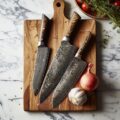Introduction: Embracing Kitchen Tool Wisdom
The kitchen is often called the heart of the home, a place where nourishment and love come together. As we navigate this culinary sanctuary, our trusty kitchen tools are our faithful companions. However, even the most well-intentioned home cooks can sometimes misuse these helpful gadgets. In this compassionate guide, we’ll explore common kitchen tool mistakes and how to avoid them, ensuring that your cooking experience is not only efficient but also joyful and fulfilling.
Knife Know-How: Handling with Care and Precision
Knives are perhaps the most essential tools in any kitchen, but they’re often misunderstood. One common mistake is using dull knives, which can be dangerous and frustrating. Remember, a sharp knife is a safe knife! Here are some tips for proper knife care:
- Regularly sharpen your knives to maintain their edge
- Store knives in a knife block or on a magnetic strip to protect the blades
- Always cut on a proper cutting board, never on metal or stone surfaces
- Use the right knife for the job – a paring knife for small tasks, a chef’s knife for larger ones
By treating your knives with respect, you’ll find that food preparation becomes a meditative and enjoyable process.
Cutting Board Considerations: Choosing and Using Wisely
Cutting boards are the unsung heroes of the kitchen, but they’re often neglected. Here are some common mistakes to avoid:
- Using the same board for raw meats and vegetables (cross-contamination risk)
- Failing to clean and sanitize boards properly after use
- Using glass cutting boards, which can dull knives quickly
Instead, consider having separate boards for different food types. Wooden or bamboo boards are gentle on knife edges and have natural antimicrobial properties. Remember to wash your boards with hot, soapy water after each use, and oil wooden boards occasionally to prevent cracking.
Blender Blunders: Blending with Mindfulness
Blenders are versatile tools that can transform ingredients into smooth concoctions, but they’re often misused. Here are some tips for blender bliss:
- Don’t overfill the blender jar – leave some room for ingredients to move
- Start blending at a low speed and gradually increase to avoid splatters
- For hot liquids, remove the center cap and cover with a towel to allow steam to escape
- Clean your blender immediately after use to prevent food from drying and sticking
By using your blender mindfully, you’ll create smoother blends and extend the life of this helpful appliance.
Cookware Cautions: Treating Your Pots and Pans with Love
Our pots and pans work hard for us, but they often suffer from neglect or misuse. Here are some common cookware mistakes to avoid:
- Using metal utensils on non-stick surfaces, which can scratch and damage the coating
- Putting hot pans directly into cold water, which can cause warping
- Overcrowding the pan, which can lead to steaming instead of browning
- Using high heat when medium or low would suffice
Treat your cookware with care, and it will reward you with years of faithful service. Remember, cooking is an act of love, and that extends to how we treat our tools.
Measuring Mishaps: Precision with Patience
Accurate measurements are crucial in cooking and baking, but many of us make mistakes here. Common errors include:
- Using liquid measuring cups for dry ingredients and vice versa
- Eyeballing measurements instead of using proper tools
- Not leveling off dry ingredients when measuring
- Packing ingredients like flour too tightly in the measuring cup
Remember, baking is a science, and cooking benefits from precision too. Take your time with measurements, and you’ll find your dishes turn out more consistently delicious.
FAQ: Kitchen Tool Wisdom
Q1: How often should I sharpen my kitchen knives?
A1: For home cooks, sharpening knives every 3-6 months is usually sufficient. However, you should hone your knives with a honing steel before each use to maintain the edge.
Q2: Is it safe to put my wooden cutting board in the dishwasher?
A2: It’s best to hand wash wooden cutting boards. Dishwashers can cause the wood to warp, crack, or split due to the high heat and moisture.
Q3: How can I prevent my non-stick pans from losing their coating?
A3: Use only silicone, wooden, or plastic utensils, avoid high heat, and hand wash your non-stick pans. Also, avoid using cooking sprays, which can build up and damage the coating over time.
Q4: What’s the best way to clean a blender?
A4: For easy cleaning, fill the blender halfway with warm water, add a drop of dish soap, and blend for 30 seconds. Rinse thoroughly and air dry.
Q5: How can I ensure my measuring cups are accurate?
A5: Periodically check your measuring cups against a known accurate measure. For dry ingredients, fill the cup and level it off with a straight edge. For liquids, check the measurement at eye level on a flat surface.
Conclusion: Cultivating Kitchen Harmony
As we’ve explored these common kitchen tool mistakes and their solutions, remember that the goal is not perfection, but rather a harmonious relationship with our culinary companions. By treating our kitchen tools with care and respect, we create a more joyful, efficient, and safe cooking environment. Let’s approach our time in the kitchen with mindfulness and love, knowing that the care we put into our tools translates directly into the nourishment we provide for ourselves and our loved ones. Happy cooking!









